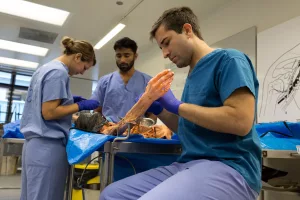Med Schools & Cadavers
 Courtesy National Geographic
Courtesy National Geographic
The pervasive odor of formaldehyde and frozen cadavers is over perhaps and the expenditure incurred by medical schools in embalming and storage is eliminated. Conventional anatomy laboratories still use human cadavers and remain operational for resident surgeons honing their surgical skills. Synthetic tissues have been developed in which the heart beats and its valves work , movements of joints takes place, incisions in outer layer are stitched, all gender and infant cadavers are available, software causes replication of bodily functions, synthetic material closely resembles almost a hundred different kinds of tissue ranging from subcutaneous fat to rectus femoris muscles. Such synthetic cadavers are made from water, salt and fibre. Synthetic cadavers are significant as they enable medical and public health researchers to gauge accurate reading of how a patient responds to trauma events or vent replacement.
Ethical considerations
The supply of ethically sourced cadavers is ensured as compared with traditional supply chains as in medical and veterinary schools for research purposes only those cadavers are available where death occurs due to natural causes or euthanisation if suffering from a terminal disease or trauma victims. Medical research depends on organ donations which is not legally permissible unless the donor is eighteen years or more and infant cadavers are extremely difficult to obtain.
Liberal Surgical Practice
The risk of exposing patients to the errors a novice surgeon may commit or the open and unfettered accessibility of a medical researcher in studying complicated features such as structures of the deep inner ear and neural pathways arduous to identify in cadavers is non-existent.
Animal lovers
It’s heartening for animal lovers to find out that the euthanasia of healthy but unwanted dogs at animal shelters, racing horses put out to pasture and abattoir specimens for the purposes of surgical dissection has significantly dropped.
Prof Dr Nazia Mumtaz

Leave A Comment